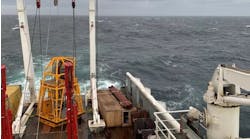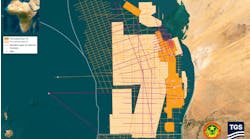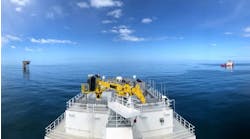North Sea use speeding S-wave adaptation
For years the seismic industry has relied on towed streamer technology for marine seismic surveys. As a result, in-sea technologies have been continuously refined, and innovations such as multiple seismic streamers and sources have brought enormous improvements in operational efficiency.This article looks at two recent North Sea surveys acquired with a four-component (4C) seabed acquisition system. It shows how the added ability to record shear wave (S-wave) data leads to improved reservoir characterization, and highlights the tremendous improvement in conventional P-wave data quality that can result from seabed acquisition employing properly engineered equipment.
Four-component seismic surveys are becoming increasingly popular for detailed analysis of producing reservoirs. Features such as escaped gas (often found in zones above reservoirs) degrade conventional seismic P-wave seismic data, but do not affect the S-waves.
These precious S-wave returns can therefore be used to give a much clearer indication of the reservoir structure. In addition, 4C data can be used for predicting lithologies and pore fluids, and are now showing promise for mapping low-impedance-contrast reservoirs not visible on conventional seismic data, and also for mapping hydrocarbon saturation between wells.
Shear waves cannot pass through water, so towed streamer technology is essentially useless for S-wave recordings. In the past few years Schlumberger Geco-Prakla has developed the highly efficient Nessie 4C MultiWave Array seabed acquisition system, which consistently has proven to deliver very high quality multicomponent (P- and S-wave) data.
North Sea applications
Geco-Prakla first started using its system in 1996 to acquire 4C data in the North Sea and has since used the Nessie 4C system in the Gulf of Mexico, the Far East, and Australia, in waters up to 700 meters deep. With the benefit of 30 surveys under its belt, Geco-Prakla now predicts that annual global spending on 4C acquisition will reach $600 million by 2005.Four component acquisition appears to be following a similar growth pattern as was experienced with 3D seismic in the 1980s. "We are probably a third of the way through the same kind of growth curve we were in 1986 with 3D seismic," comments Dr Olav Holberg, Head of Geco-Prakla Reservoir Characterization and Monitoring. Holberg believes that the economics of 4C acquisition are fast reaching the point where it will be competitive for surveys over producing fields - especially in areas where undershooting of production facilities poses a problem for towed streamer acquisition.
Recent surveys by Amoco in the Valhall Field of the North Sea have strengthened the case for 4C acquisition. Escaped gas distorts the P-wave data acquired using towed streamers. The image lacks any clear definition. In contrast, the S-wave data acquired using the Nessie 4C MultiWave Array system are unaffected by the gas cloud, giving a much clearer picture of the substructure.
Higher resolution
Geco-Prakla claims that recent surveys for Saga Petroleum show that its Nessie 4C system has the edge over both conventional towed streamer and conventional ocean bottom cable acquisition in terms of data quality.This marked improvement is due to the improved seabed coupling of the geophones and the elimination of the receiver ghost. The stationary seabed cable brings further advantages:
- It avoids data smearing caused by streamer feathering and binning
- It has a better signal-to-noise ratio due to the lack of tug, tow and wave action on the equipment.
"There is no doubt that we shall see improvements in 4C technology and data analysis in the relatively near future. In a couple of years, we may find companies regretting that they opted for today's towed streamer technology for time-lapse and production surveys when they could have acquired better quality data sets with much higher information content for relatively little extra expenditure," says Holberg.
Copyright 1998 Oil & Gas Journal. All Rights Reserved.


